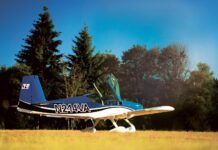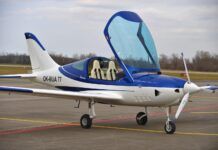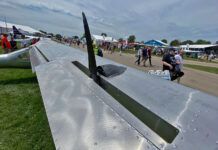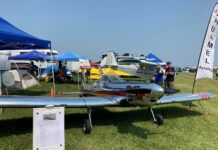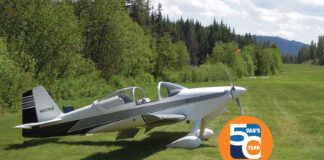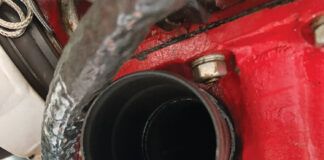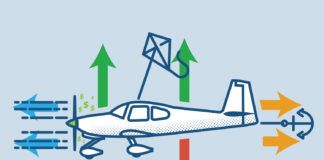The October 07 issue of KITPLANES introduced my neighbor, John Horn, and his decision to buy a Flight Design CTSW (“composite technology, short-wing”) Special (factory-built) Light Sport Aircraft. Horn researched many of the 40-plus SLSAs and flew four of them. The German-designed, European-built CTSW two-seater is still among the best-selling Light Sport Aircraft, and Horn is enjoying every flight in his high-tech little plane.
Built mostly of carbon fiber and Kevlar, his CTSW is equipped with a Dynon EFIS-D100 (plus backup round gauges) and a docking station for his Garmin GPSMAP496. For some time, Horn and I talked about flying the CT together, and on a recent blustery Sunday afternoon, we flew long enough for me to get a good feel for the airplane.
Getting Ready
Earlier in the day, Horn had flown less than 3 gallons out of the 34-gallon wing tanks, and the plastic tube wingroot sight gauges confirmed that both tanks were still nearly full. Other preflight duties included moving the bottom of the right seat into a comfortable position to allow me full rudder pedal deflection.
Like most of the European SLSAs, the CTSW is powered by a 100-horsepower Rotax 912S engine. Rotax recommends 92 octane premium automotive gasoline, and Horn fuels his plane using a ladder and a portable tank, hose and nozzle pressurized by CO2.
The preflight/prestart checklist is lengthy and detailed, and removing the emergency parachute safety pin is on the list (all CTs sold by Flight Designs USA come with a BRS chute). The engine started smoothly without using the choke. A tiny red valve handle sets and releases the parking brake system, which pressurizes the non-differential wheel brakes controlled by a large lever on the lower center console. Considerable rudder pedal pressure is needed to steer while taxiing.
Lets Fly
The pre-takeoff checklist calls for extending flaps to 15 but no-flap takeoffs are approved on long runways. Horn demonstrated the takeoff, and we climbed at 63 knots indicated. The Dynon 100 and conventional vertical speed indicators disagreed on the rate of climb, which was probably close to 900 fpm at our weight-about 45 pounds less than the 1320-pound maximum.
It seems the flaps are always moving in a CTSW. At pattern altitude and airspeed, the four-position electric flap switch on the center console is moved to the zero position. Before accelerating through 100 knots, the flap switch should be set to -6, a cruise reflex setting like sailplanes use for high-speed dashes between thermals. Speed limits for each flap setting are placarded.
My first few turns revealed that CTSW flight controls are different from the majority of homebuilts and also from many of the other sleek LSAs. Compared with most high-performance homebuilts, pitch and yaw are not particularly sensitive in the CTSW but certainly produce quick results compared with most Cessnas and Pipers. Aileron displacement requires more force than elevator and rudder, possibly because the CTSW incorporates centering springs in the aileron circuit.
Learning to coordinate rolls into and out of turns without looking at the slip/skid ball will require a bit of flight time, even if you routinely use your feet when maneuvering. My first attempt at a rapid roll from a left 45 bank to a right bank was clumsy (too much rudder for the applied aileron) but resulted in an estimated 2.5-second duration from bank to opposite bank. Thats not bad for an estimated 175 pounds of fuel in the wings.
My other surprise was the initial difficulty in determining level flight without checking a VSI or the altimeter. The problem, I think, is the unusually large windscreen, especially in the vertical dimension. My tendency was to point the nose too high while turning and recovering from a turn. If the airplane were mine, Id cheat for the first few hours and place a tape dot inside the windscreen representing cruise flight attitude for my sitting height. By the time we returned to the airport environment, pitch attitude had ceased to be a problem. Another note on the excellent view from the cockpit: Inside-the-turn visibility through the skylight is good in a bank of 35 or more.
At 3700 feet MSL, we saw 122 knots indicated at full throttle, which gave 5300 engine rpm (well below the Rotax-recommended continuous limit of 5500 rpm). Outside temperature was 14 C, resulting in a true airspeed of 124 knots. Cabin heat worked well to keep us comfortable on this chilly day.
The CTSW demonstrated its required SLSA pitch stability with a return to cruise airspeed and attitude in two cycles after being disturbed in pitch.
A partial-power (4800 rpm) departure stall attempt was abandoned before the break; there was plenty of buffeting and heavy back pressure to warn of an impending stall. Next, setting up for an approach stall, I slowed to 80 knots (maximum positive flap speed), and we got as slow as 42 knots indicated before pre-stall buffet set in. Recovery with full power followed by flap retraction had us climbing in a few seconds.
Back in the Pattern
Approaching the home airport, we crossed the field and turned downwind with carb heat on. Abeam touchdown, we held 80 knots, selected 15 of flaps, and Horn demonstrated the first approach and landing. Finding us slightly low, he left the flaps at 15 rather than selecting full flaps (40). Approach speed with this setting was near 60 knots.
After Horns touchdown, I taxied back for my first takeoff. On the takeoff roll, with 15 of flaps set, I added a few ounces of back pressure, and we were airborne in about 5 seconds. As Horn had mentioned, it takes quite a bit of right rudder pressure in the first part of the takeoff. On the crosswind leg, I raised the flaps and held close to 75 knots downwind. Dropping the flaps to 15 abeam the touchdown point helped slow us to 67 knots on the base leg. Little trim change was required, but left rudder was needed to center the ball. I used 67 knots on base and final.
Turning final, I selected full flaps (40) so that more power could be used, keeping the rpm above the yellow tachometer arc (1550 to 1800 rpm). A left crosswind called for a sideslip on final to remain near the runway centerline, and then reducing the slip as the crosswind abated near the surface just before a reasonably soft touchdown on the left mainwheel.
We taxied back for another go with Horn on the controls. Like many pilots, I never look at airspeed just before landing. But with Horn flying, I noted we had 56 knots on short final and 52 knots at touchdown-extra speed that would not be needed in smooth air straight down the runway. After his landing, Horn raised flaps to the -6 reflex setting to minimize the chance of hitting his head on the flaps during the next preflight.
Some Final Thoughts
Although the CTSW served up a few surprises, this is one fine airplane, as the sales figures indicate. Purchase price includes 3 hours of transition training, which should be enough for a proficient pilot to become competent. Mastering the airplane to feel completely comfortable, however, is likely to take longer.
The CTSW offers lots of capacity, but you probably cant use it all at once: 34 gallons of fuel, 110 pounds of baggage, and room for two big people. Take your choice, but stay in the weight and balance envelope.
As a high-time pilot and flight instructor, John Horn anticipates that inexperienced pilots transitioning to the CT will require some flight time to acclimate. “On the other hand,” he said, “those pilots who start from scratch in this airplane will probably have no difficulty in anything they get their hands on.” He now has 62 hours on his CTSW.
Flight Design now offers an additional model called the CTLS, which has even more cabin room, implies more docile handling, and comes as a complete package including state-of-the-art avionics and displays. I look forward to flying it and reporting differences here. Meanwhile, Flight Design intends to continue marketing the CTSW.
For more information, call 860/963-7272 or visit www.flightdesignusa.com. A direct link can be found at www.kitplanes.com.




